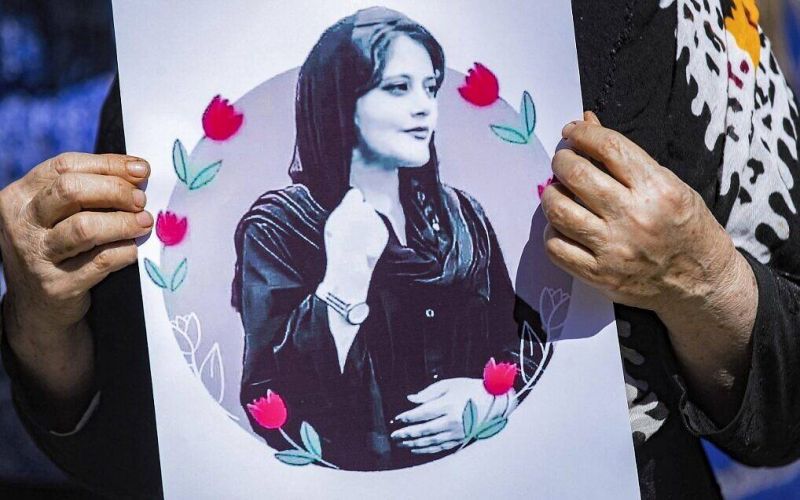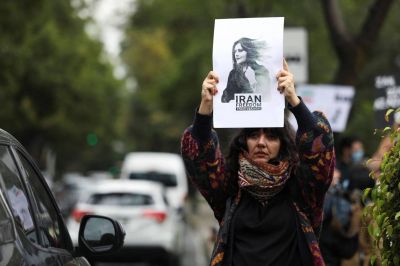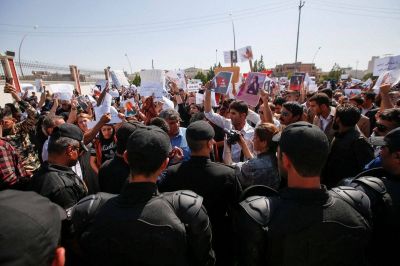
A woman holds up a sign depicting a picture of 22-year-old Mahsa Amini, an Iranian woman who died while in the custody of Iranian authorities, during a solidarity demonstration in Syria's northeastern city of Hasakeh on September 25, 2022. (Credit: Delil Souleiman/AFP)
SULAIMANIYAH — Iranian Kurdish woman Mahsa Amini was visiting Tehran with her family when she encountered the notorious morality police and died after a “violent blow to the head,” according to her cousin who lives in Iraq.
“Jhina’s death has opened the doors of popular anger,” said Erfan Salih Mortezaee, 34, using Amini’s Kurdish first name and referring to the ongoing wave of protests sparked by her death.
Amini’s mother called Mortezaee to tell him what happened to her 22-year-old daughter in police custody, he said.
AFP spoke with Mortezaee in Iraq’s autonomous Kurdistan region — bordering Amini’s native Kurdistan province in Iran — where he has been living for a year.
There he joined Iranian Kurdish nationalist group Komala, which has conducted a long-running cross-border insurgency against the Tehran authorities, seeking autonomy for Kurdish-populated areas of northwestern Iran.
Mortezaee said that, before starting university, Amini had gone to Tehran with her parents and 17-year-old brother to visit relatives.
On Sept. 13, Amini, her brother and female relatives went out in the capital. After leaving the Haghani underground station, “the morality police stopped them, arresting Jhina and her relatives,” Mortezaee said.
Wearing military fatigues and speaking from a Komala base in the Sulaimaniyah area of northern Iraq, Mortezaee said Amini’s brother tried to tell the police that they were “in Tehran for the first time” and “did not know the [local] traditions.”
But his appeals fell on deaf ears.
Beatings
“The police officer told him, ‘We are going to take her in, instill the rules in her and teach her how to wear the hijab and how to dress,'” Mortezaee said.
Amini was “dressed normally. Like all women in Iran, she was wearing the hijab,” her cousin added.
In Iran, women — regardless of their faith — are required to cover their hair, and the morality police bans them from wearing coats above the knee, tight trousers, bright colors or torn jeans.
The code has been widely skirted for decades, particularly in major cities, but there have been periodic crackdowns.
“The police officers hit Jhina, they hit her in front of her brother,” Mortezaee said. “They slapped her, they hit her hands and legs with a baton,” said Mortezaee, adding that they also sprayed her brother in the face with pepper spray.
Jhina and her relatives were forced into the morality police van and taken to a station on Vezarat Street. The beatings continued during the ride, Mortezaee said. “When they hit her in the head with the baton, she lost consciousness,” he said. “One of the officers said: ‘She’s putting on an act.'”
After they arrived at the station, it was at least another hour and a half before Amini was taken to a Tehran hospital, despite pleas from her relatives, Mortezaee said.
After three days in a coma, she was pronounced dead.
‘Better life’
Amini’s mother said doctors at the hospital told the family that her daughter “had received a violent blow to the head,” Mortezaee said.
Iranian authorities have denied all involvement in Amini’s death, which has sparked 12 consecutive nights of protests and a brutal security crackdown.
“What is happening in Kurdistan and everywhere else in Iran is popular anger against the Islamic Republic’s regime, against the dictatorship,” Mortezaee said.
At least 76 people have been killed in the demonstrations, according to the Oslo-based group Iran Human Rights (IHR), while Iran’s semi-official Fars news agency has placed the death toll “around 60.”
Authorities said Monday they had made more than 1,200 arrests.
The protests come at a particularly sensitive time for Iran’s leadership, when the country’s economy remains mired in a crisis largely caused by US sanctions over its nuclear program. The country has seen protests in recent years, including deadly demonstrations in November 2019 over rising fuel price.
But this time “women are taking the lead and are actively taking part in the protests,” Mortezaee said. “Women are participating in the demonstrations courageously and are taking to the streets, day and night,” he said.
“We, the youth, know that if this regime falls, a better life awaits us.”

